The challenge and promise of studying burning plasmas
DOI: 10.1063/PT.3.4363
In burning plasmas, the energy from charged particles created by fusion reactions compensates for heat loss. Burning plasmas power the Sun and other stars, and they could provide abundant energy for humankind. In the Sun, proton fuel is used in fusion reactions. But on Earth, the highest performance fuel is composed of deuterium and tritium ions. Scientists have several ways of producing fusion energy in the laboratory, most notably through magnetic and inertial confinement.

© ITER ORGANIZATION
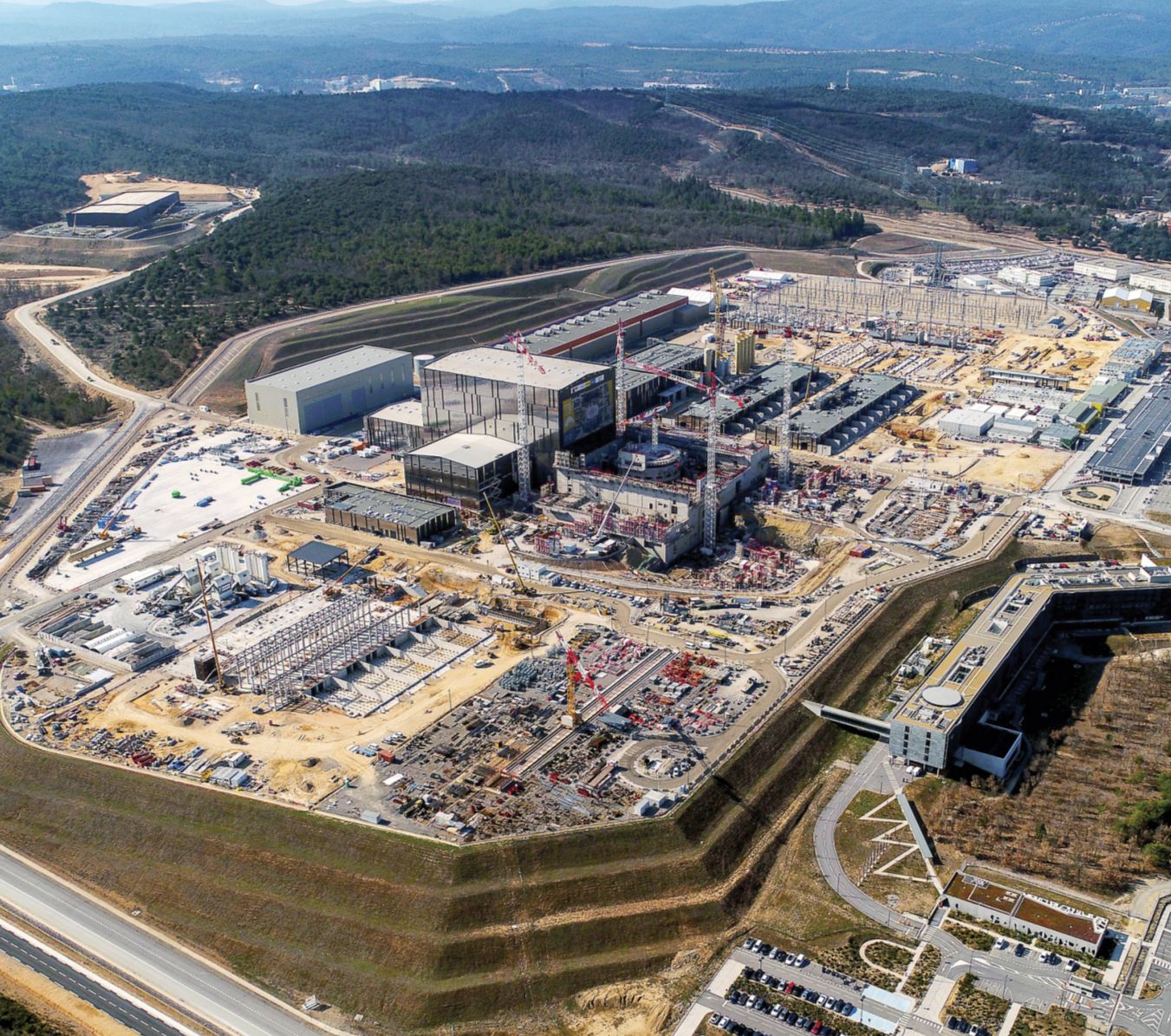
The progress made on magnetic fusion has led to the planning and construction of ITER, the international fusion research facility. Significant fusion power has been achieved for a little less than a second in magnetically confined plasmas—up to 10 MW in the Tokamak Fusion Test Reactor in the US 1 and up to 16 MW in the Joint European Torus in the UK. 2 In those experiments, the deuterium–tritium fuel is self-heated by fusion products—alpha particles—which provide a modest fraction (less than 13%) of the total heat supplied to the plasma. Whereas the original ITER design was based extensively on empirical results, designs for tokamak power plants such as those run by EUROfusion increasingly use theoretical and computational research coupled with empirical results from current experiments.
The construction of ITER in Provence, France, is already underway as shown in the opening photo. The facility will provide the opportunity to study burning plasmas in which at least two-thirds of the total heating will come from fusion reactions that could produce 500 MW of power for more than 300 seconds. The facility will also enable the first in-depth study of burning plasmas in a magnetic confinement configuration.
3
ITER will be one of the largest scientific experiments ever undertaken, with participation by China, the European Union, India, Japan, Russia, South Korea, and the US. Despite the high cost of the project, the worldwide community’s sharing of scientific and technical knowledge has contributed to the breadth of the international collaboration. Although project costs increased and the construction schedule was delayed early on, ITER has been successfully adhering to the current schedule in recent years after a major reorganization in 2015 (see Physics Today, May 2015, page 21
ITER will create an axisymmetric toroidal plasma inside a chamber, whose cross-sectional view is shown in figure
Figure 1.

The poloidal cross section of ITER shows a magnetic separatrix that encircles closed magnetic flux surfaces. The separatrix is introduced by creating a so-called X-point, in which the plasma field current interacts with the current that’s transported by a large superconducting divertor coil. Closed magnetic surfaces exist inside the separatrix, and the plasma outside it flows in the narrow, few-mm-wide scrape-off layer toward the divertor. The dashed, red line indicates the size of the major radius
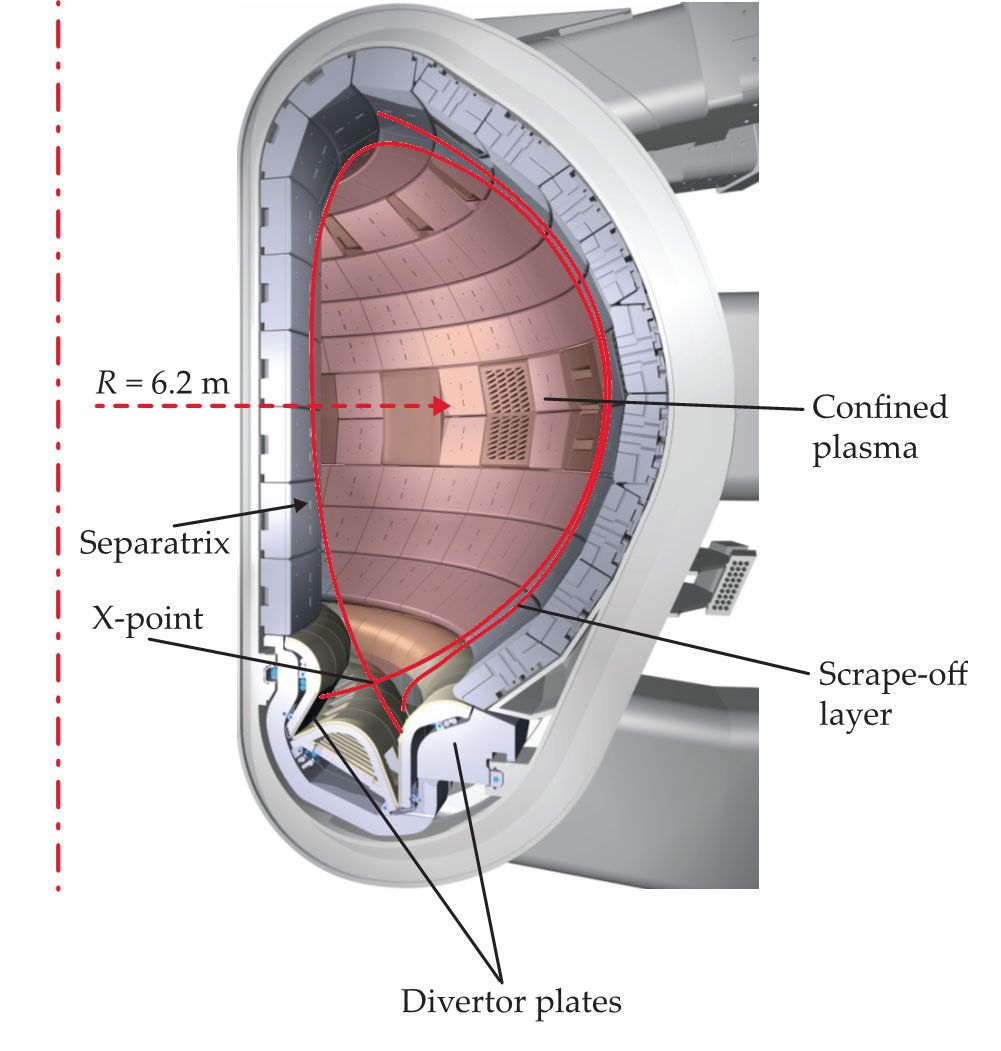
Once the plasma pressure is sufficiently high, the self-heated phase begins. During that burning phase, fusion reactions generate suprathermal alpha particles, which are confined by the magnetic field and heat the plasma as collisions with the background plasma slow them down. The alpha particles self-heat the plasma about twice as much as any external heating source, and 80% of the fusion power is released as energetic neutrons, which do not interact with the plasma. Their energy is transferred as heat to the surrounding blanket; in power plants, the blanket converts the heat to electricity. Twisting magnetic fields that lie on nested toroidal magnetic flux surfaces confine the plasma in the core. But outside of the last closed-flux surface, called the separatrix, the magnetic field lines are no longer closed and thus intersect the first wall, ideally in the so-called divertor region beyond the scrape-off layer, seen in figure
Producing a burning plasma requires plasma parameters that are different from those in current, nonburning experiments. Similar to fluid dynamics, dimensionless parameters for the core plasma can be determined theoretically and then the plasma’s behavior can be scaled from one set of experiments to another.
4
ITER will have to simultaneously achieve several conditions. Large values of system size, which are related to how many ion Larmor radii
Another parameter has been found to describe various limitations to the plasma density
Present-day experiments, individually but not simultaneously, can achieve ITER’s typical parameter values. Therefore, scientists will use ITER to study burning plasmas and the unique regime of dimensionless parameters, important for facilities that will produce electricity from burning magnetically confined deuterium–tritium plasmas. 5
Transporting heat and particles in the plasma core
ITER was designed mainly using empirical projections of the confinement of heat in the plasma based on experimental results from around the world. The results come from a mode of operation in which there is reduced turbulent transport in the edge region.
5
The so-called H-mode, or high-confinement mode, is a consequence of sheared plasma flow that breaks up turbulent eddies.
6
The eddies generate a narrow zone of steep radial gradients in the edge that corresponds to the pedestal region shown in figure
Figure 2.

A typical ion temperature profile, plotted versus the normalized minor radius of the confined plasma, features a pedestal region (green) of steep gradients at the plasma edge. In ITER, the expected temperature values will be about five times as high. (Adapted from ref.
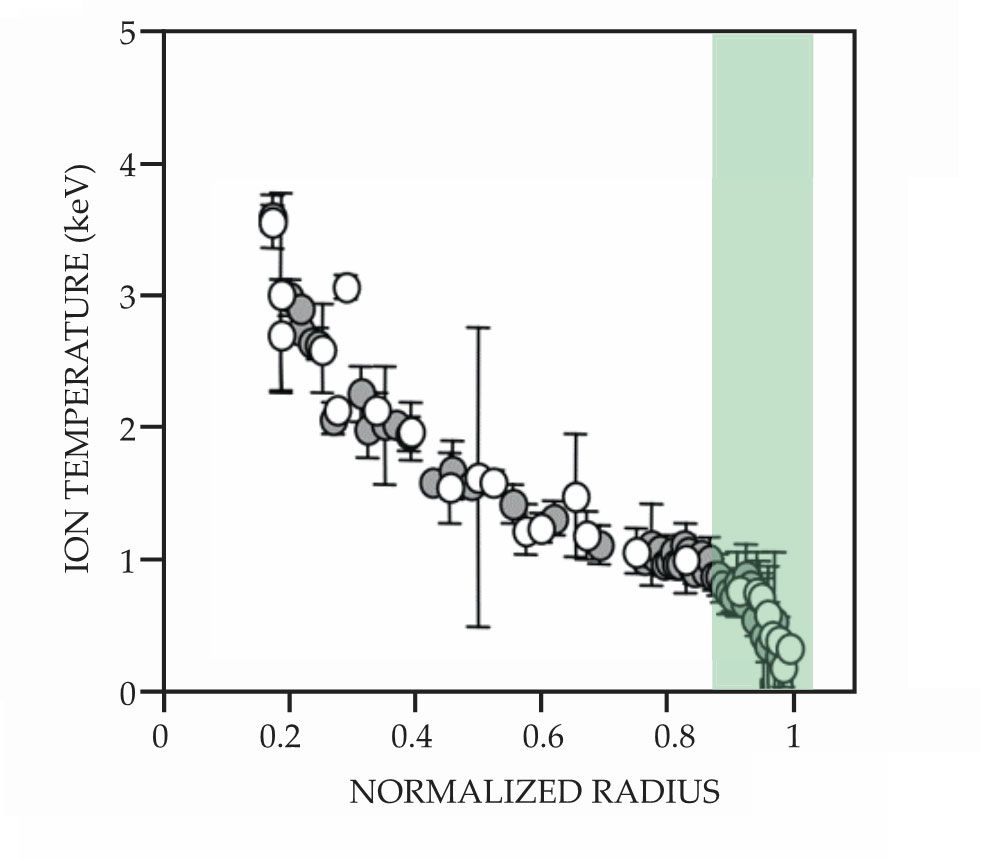
Since the ITER facility design began, scientists have made substantial progress in understanding the turbulent processes in the core and comparing detailed experimental results with sophisticated theoretical models. One such model indicates that heat flux is not simply proportional to the temperature gradient but can be highly nonlinear. The heat flux strongly increases above a threshold value for the normalized temperature gradient
ITER is predicted to operate in a range in which those turbulent processes are important, so the temperature in the plasma core is approximately proportional to the temperature at the top of the pedestal. The sensitivity of the predicted fusion power to the pedestal temperature is illustrated in figure
Figure 3.

The fusion power
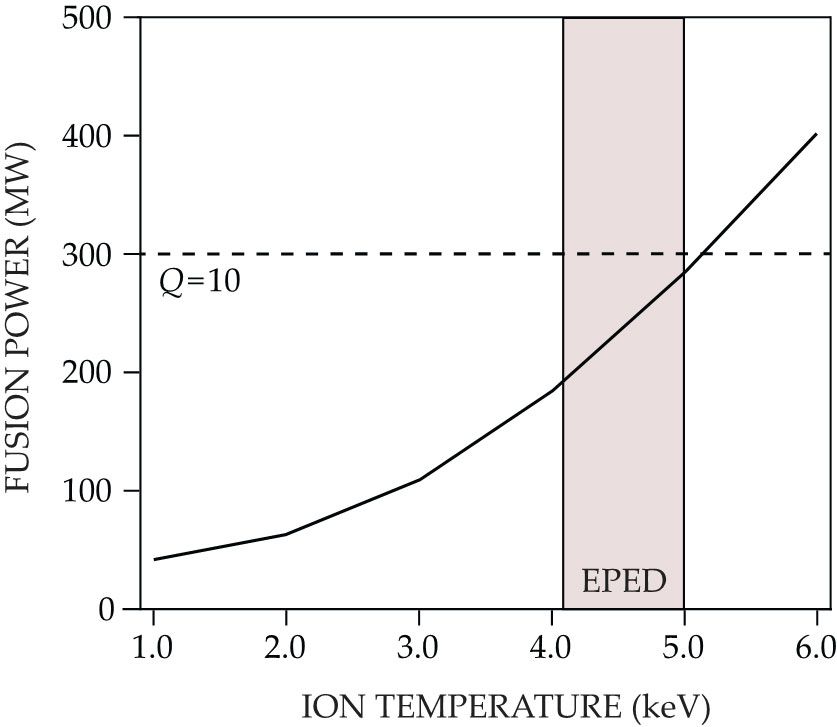
The modeling of the nonlinear, turbulent plasma state has become increasingly more sophisticated. Some have described how the rotation in the plasma arises from a combination of externally applied torque from the injection of neutral beams and from turbulence-induced processes, a phenomenon known as Reynold’s stress in fluid dynamics. So the same turbulence that mainly determines the loss of heat can enhance the plasma rotation and help in determining the saturation level of turbulent transport. Even for plasmas with no applied torque, significant rotation is observed. Although the applied torque for ITER is smaller than in current experiments, it may still drive enough rotation to improve performance, and additional rotation may be driven by turbulent processes. Modeling now simultaneously considers turbulence at both ion- and electron-scale lengths, the role of shear in the profile of plasma rotation, and the effect of fast ions in the relationship between the heat flux and the normalized temperature gradient. 8 Experiments have shown regimes of operation in which the heat flux may decrease because of an increase in the plasma rotation or the presence of fast ions.
Experiments and theory predict that turbulence results in particle transport and produces a peaking of the electron density profile in low-collisionality plasmas, in which the mean free path between Coulomb collisions is much longer than the characteristic distance around the plasma along magnetic field lines. 9 That is advantageous for fusion reactivity because the fuel concentrates in the high-temperature part of the plasma. In present-day experiments, low collisionality is only achieved at low normalized density. ITER and future power-producing experiments, however, will operate at high normalized density. Such experiments will therefore be important in validating the theoretical models in new regimes where the fast ion effects are due to alpha particles operating at very low collisionality and in large systems. In addition to transporting the main fuel species, it’s important to transport the alpha-particle ash from the deuterium–tritium reactions to the edge and subsequently pump the ash to avoid accumulating impurities and diluting the fuel. Turbulent processes are expected to dominate collisional processes and will help determine the fuel dilution and the presence of impurities in the core from plasma material interaction at the edge.
Pedestal performance
The reduced transport in the edge region associated with H-mode plasma results in steep temperature and pressure gradients, as shown in figure
Figure 4.

An edge-localized mode (ELM) instability appears on this fast camera image from the Mega Amp Spherical Tokamak. The wide-angle view shows the whole plasma, and the enhanced hydrogenic line emission clearly delineates plasma filaments, which are ejected from the edge by the ELM instability.
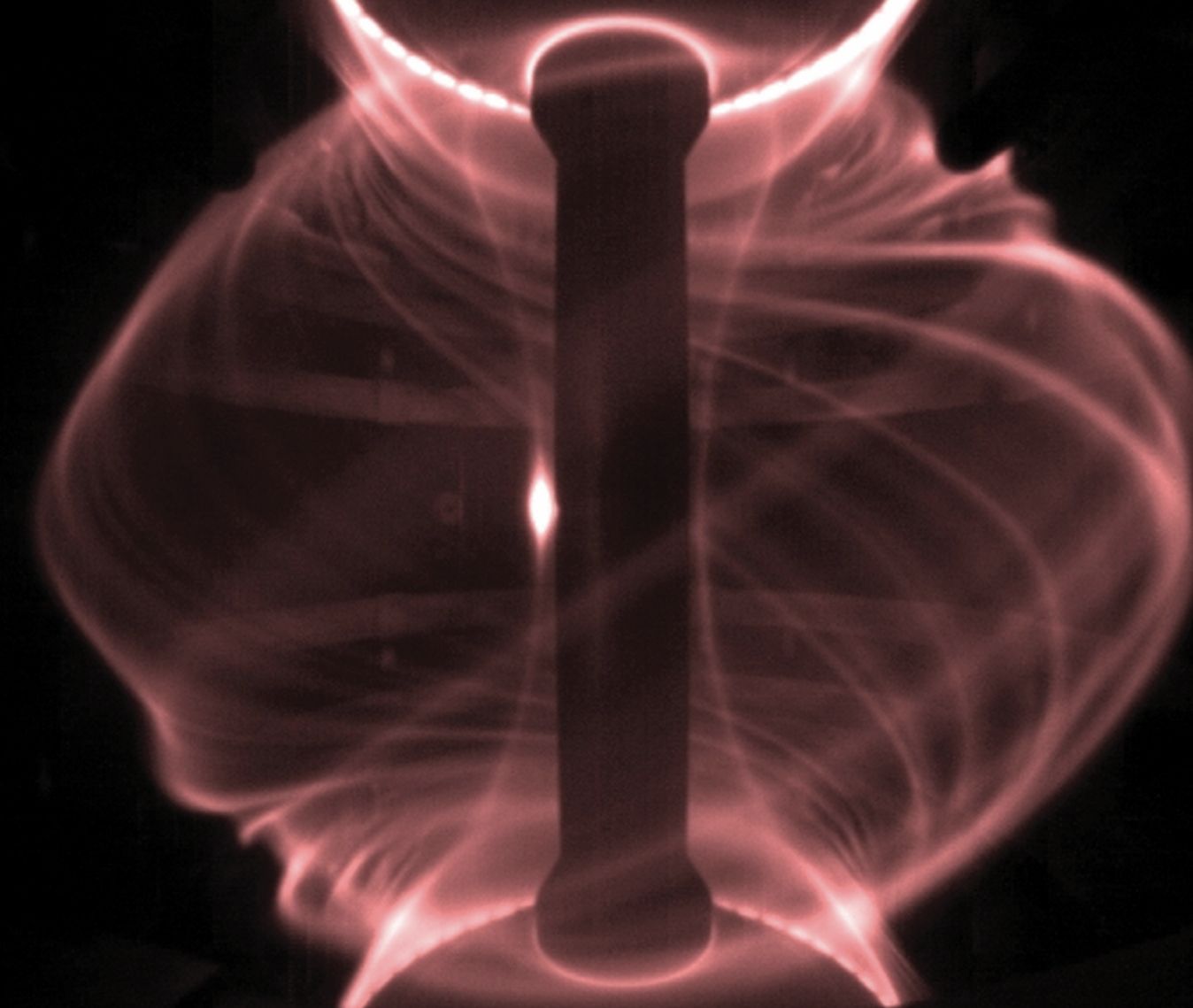
Whereas the global pedestal stability is described well by linear, ideal MHD modeling, the parameters at the top of the pedestal are determined by a combination of MHD stability and the transport mechanisms between the edge of the plasma and the top of the pedestal. The edge pedestal (EPED) model successfully predicts the width and height of the pedestal pressure by combining linear MHD stability analysis of the pedestal with a simplified assumption about the transport in the region. 11
However, recent experiments using tungsten as a wall material in the Axially Symmetric Divertor Experiment (ASDEX) Upgrade and the Joint European Torus tokamaks have shown a degradation that could not be explained by the MHD model. The temperature and density profiles can respond differently, partly because of an influx of recycled neutral particles from the wall into the region between the plasma edge and the pedestal top. Consequently, additional transport physics will have to be incorporated into the EPED model to improve predictions.
ITER will be operating in a different system-size regime from its predecessors, so the role of neutrals may change. ITER’s combination of low collisionality and large system size may alter the turbulence characteristics in the pedestal region and affect the height of the pedestal. As the first device to combine a pedestal with low-collisionality parameters and operate at high densities relative to the Greenwald density, ITER provides a unique opportunity to validate the understanding of the edge pedestal.
For ITER, the large ELM instabilities could damage divertor components. Techniques have been developed to suppress those instabilities, such as by operating within the stability boundary with additional coils that give rise to small three-dimensional perturbations of the tokamak axisymmetry,
Plasma-boundary interactions
A major challenge for ITER will be controlling the heat and particle exhaust. The sharp pressure gradients in the edge region extend to just beyond the last closed-flux surface from which heat and particles are rapidly transported along the open magnetic field lines to the divertor plates. Recent experiments on various devices have shown that the heat flux width at the plane where the plasma has its largest radial extension is narrow and would extrapolate to as low as 1–2 mm in ITER. Advances in transport modeling across the magnetic field on the open field lines describe the heat flux width in current experiments reasonably well. When the same model is applied to ITER, it indicates that turbulence changes in the edge may increase the heat flux width up to 5 mm. That prediction requires stringent experimental tests that may only be possible using ITER.
To illustrate the magnitude of the heat-exhaust challenge, consider that the heat flux into the ITER boundary will be 150 MW if the power lost by radiation is ignored. Taking into account the extrapolated experimental heat-flux-width range, that heat exhaust would far exceed the approximately 10 MW/m2 power-handling capability of steady-state, high-heat-flux components with tungsten armor that will be used in the ITER divertor.
Two approaches are used to reduce the heat flux on the divertor plates. In the first, the incident angle of the magnetic field lines carrying the heat flux is reduced by expanding the magnetic flux surfaces in the vicinity of the divertor plates and tailoring the angle of the plates so that they are nearly tangential to the magnetic field. That approach demands accurate alignment of individual target plates to ensure that the leading edges do not overheat. The heat flux on the target would be substantially reduced to about 40 MW/m2 in the ITER geometry. 12 The decrease depends on the heat-flux-width assumptions, but the value is comparable to the heat flux on the surface of the Sun, which is roughly 60 MW/m2.
In the second approach, part of the heat flux is dissipated by intentionally injecting seed impurities, such as nitrogen, into the divertor plasma. The impurities will emit line radiation to distribute the heat load homogeneously in all directions. At constant-impurity concentration, the radiation losses increase with the square of the electron density. A high density at the separatrix is also required for effective power dissipation. Both techniques have been successfully demonstrated for various experiments. Figure
Figure 5.

Two tomographic reconstructions of impurity radiation from the divertor and X-point regions show clear differences in their enhanced radiation losses. For an experiment of the ASDEX Upgrade tokamak without additional impurities (left), about 50% of the heating power is dissipated by electromagnetic radiation. But when nitrogen seeding is added (right), a zone of high radiation occurs at the X-point, and the radiated power fraction rises to values in excess of 80%. (Adapted from ref.
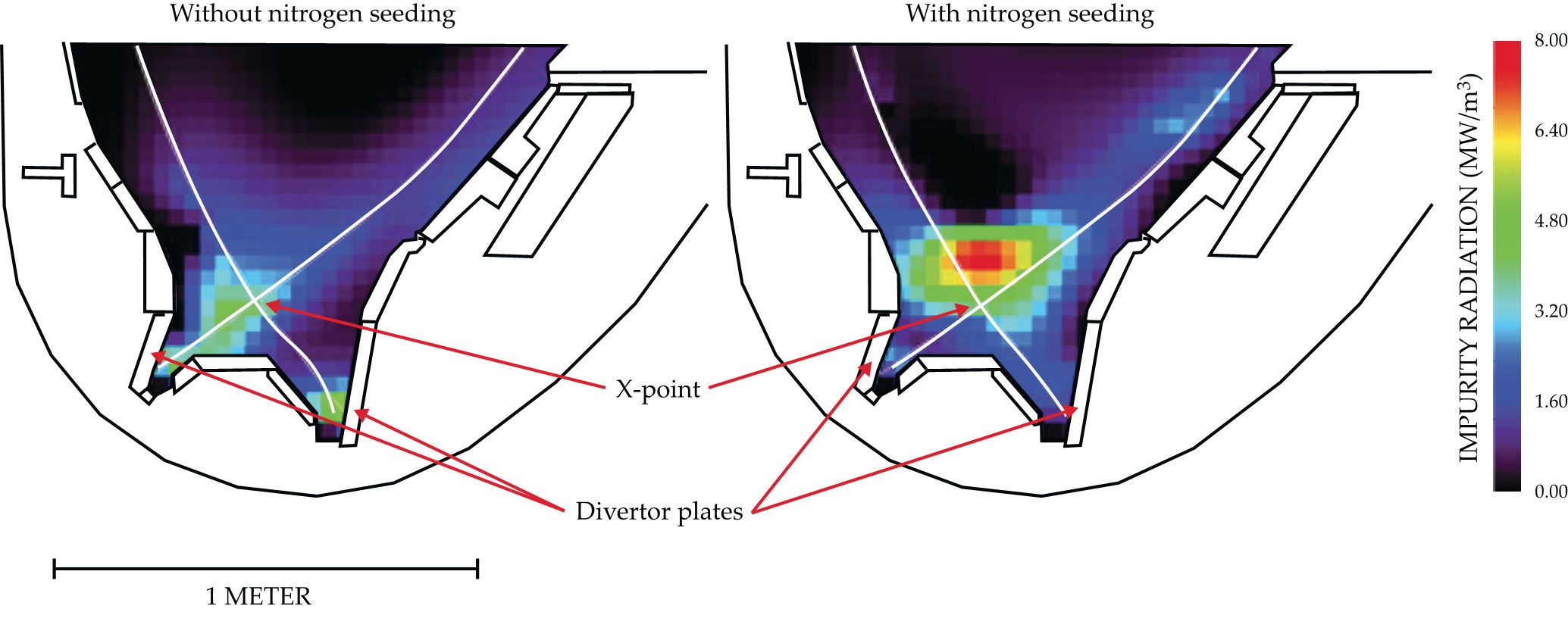
One role of ITER is to test ideas to stably exhaust power and particles in a future fusion power plant at relatively high separatrix densities while simultaneously optimizing the fusion power. Among the questions to be addressed are Will confinement be degraded because of the high density in the scrape-off plasma as seen in present-day experiments? And will the fuel concentration in the core be decreased by impurity ions penetrating the core from the divertor plasma, which reduces the plasma reactivity?
Control of burning plasmas
Perhaps the most important question is whether the high-energy alpha particles that sustainably heat the burning plasma deposit their energy to the ions and electrons via Coulomb collisions or whether their interaction with electromagnetic waves results in a spatial redistribution or loss of alpha particles. (See the article by David Pace, Bill Heidbrink, and Michael Van Zeeland, Physics Today, October 2015, page 34
However, in those experiments, the ratio of intrinsic alpha-heating to external heating was small, about 10% or less. ITER will be the first device to conduct experiments that have the alpha-heating dominating the heating power, that address the nonlinear wave–particle interaction, and that decrease the uncertainty associated with low-power alpha-heating experiments. ITER will be able to test whether electromagnetic waves generated by the energetic alpha particles are less stable than in current experiments due to the large system size. Those results will enable researchers to determine optimal operating conditions and minimize or even avoid such instabilities.
Controlling fusion power in a burning plasma would appear to be straightforward. The fusion reactivity in ITER decreases with increasing temperature, and the confinement time of the plasma energy decreases with heating power, which enables a stable operating point. The problem becomes more interesting when the consequences of changes in confinement are considered. In future power plants, a 10% increase in confinement could roughly double the fusion power. The power increase could provide feedback control because it occurs over the time scale of several energy confinement times. Large concentrations of fast ions can reduce the plasma confinement and decrease the efficiency of the alpha-particle heating by interacting with electromagnetic waves. Hence there is significant uncertainty about how the fast ions will affect the burn-control dynamics and whether the system will respond nonlinearly. Only ITER, with its dominant self-heating by alpha particles, will enable a comprehensive exploration of burn control.
Researchers do know that burn control is affected by additional operational constraints related to the maximum density; the MHD stability of the plasma, which is strongly related to the plasma pressure; and the heat flux to the plasma-facing components. Consider the effect of increasing the plasma density. In principle, it’s advantageous because it increases plasma reactivity and the power radiated. However, as the density approaches its maximum, observations show that the confinement time degrades. Experimental physicists are using theoretical models to help fine-tune the experimental conditions to optimize the performance and prevent the plasma from touching the operational boundaries. Sophisticated plasma control systems manage various actuators, such as fueling by gas valves, frozen deuterium pellets, and the auxiliary heating power.
The simulations used to predict the discharge performance for ITER will need to take into account the alpha-heating dynamics and the plasma control systems to avoid breaching an operational boundary. The challenge is that the control actuators, such as for auxiliary heating, have a smaller effect on burning plasmas than in present experiments because alpha heating will play a larger role in the power balance. 13
Demonstrating control of a burning plasma in ITER for both inductive and noninductive regimes is essential before extrapolating to a power plant. During the flat-top phase of the discharge, the current for an inductive regime is driven by a flux change from a central solenoid, whereas the flux change is essentially zero in a noninductive regime. The required power amplification in a plant is expected to be higher,
Touching an operational boundary can lead to the occurrence of MHD instabilities that can terminate the plasma discharge. In present experiments, the worst plasma confinement disruption occurs when a substantial plasma current of the order of 1 MA is lost rapidly on a time scale of several milliseconds. In ITER, 15 MA of plasma current could be rapidly terminated over a somewhat longer time. A sudden termination of the plasma discharge generates large toroidal electric fields that can drive energetic runaway electron currents, transmit heat fluxes to the plasma-facing components, and apply large forces to the vacuum vessel and its components. Mitigation systems are being implemented to ameliorate the disruptions if the operating boundaries are exceeded, and active control systems will be used to ensure that the plasma operates within safe boundaries. Furthermore, active control of MHD instabilities—including by driving an additional current in the plasma by injecting RF waves or by applying 3D magnetic field perturbations—has made a lot of progress. Research has demonstrated that a localized current of a few percent of the total plasma current created through the injection of RF waves can be sufficient to remove magnetic islands that are responsible for some disruptions and will likely be used in ITER.
Experiments with the forthcoming ITER will be a unique opportunity to study burning plasmas, develop the tools needed to better understand them, and validate outstanding predictions. The experiments will provide seminal answers to questions that are central to the prospects for fusion. ITER will be a major step in bridging the gap between current understanding and the knowledge needed to design and operate fusion power plants as safe, sustainable energy sources.
The authors thank Robert Goldston, Greg Hammett, Arne Kallenbach, and Tim Luce for their thorough review and for their valuable comments and suggestions. Author Hawryluk was supported by the US Department of Energy award DE-AC02-09CH11466.
References
1. R. J. Hawryluk, Rev. Mod. Phys. 70, 537 (1998). https://doi.org/10.1103/RevModPhys.70.537
2. M. Keilhacker et al., Nucl. Fusion 39, 209 (1999). https://doi.org/10.1088/0029-5515/39/2/306
3. National Academies of Sciences, Engineering, and Medicine, Final Report of the Committee on a Strategic Plan for U.S. Burning Plasma Research, National Academies Press (2019).
4. T. C. Luce, C. C. Petty, J. G. Cordey, Plasma Phys. Control. Fusion 50, 043001 (2008). https://doi.org/10.1088/0741-3335/50/4/043001
5. M. Shimada et al., Nucl. Fusion 47, S1 (2007). https://doi.org/10.1088/0029-5515/47/6/S01
6. F. Wagner, Plasma Phys. Control. Fusion 49, B1 (2007). https://doi.org/10.1088/0741-3335/49/12B/S01
7. M. Kotschenreuther et al., Phys. Plasmas 2, 2381 (1995). https://doi.org/10.1063/1.871261
8. X. Garbet et al., Nucl. Fusion 50, 043002 (2010). https://doi.org/10.1088/0029-5515/50/4/043002
9. C. Angioni et al., Plasma Phys. Control. Fusion 51, 124017 (2009). https://doi.org/10.1088/0741-3335/51/12/124017
10. H. Zohm, Plasma Phys. Control. Fusion 38, 105 (1996). https://doi.org/10.1088/0741-3335/38/2/001
11. P. B. Snyder et al., Nucl. Fusion 51, 103016 (2011). https://doi.org/10.1088/0029-5515/51/10/103016
12. R. A. Pitts et al., J. Nucl. Mater. Suppl. 415, S957 (2011). https://doi.org/10.1016/j.jnucmat.2011.01.114
13. M. D. Boyer, E. Schuster, Plasma Phys. Control. Fusion 56, 104004 (2014). https://doi.org/10.1088/0741-3335/56/10/104004
14. H. Urano et al., Nucl. Fusion 48, 045008 (2008). https://doi.org/10.1088/0029-5515/48/4/045008
15. J. E. Kinsey et al., Nucl. Fusion 51, 083001 (2011). https://doi.org/10.1088/0029-5515/51/8/083001
16. A. Kirk et al., Phys. Rev. Lett. 96, 185001 (2006). https://doi.org/10.1103/PhysRevLett.96.185001
17. F. Reimold et al., Nucl. Fusion 55, 033004 (2015). https://doi.org/10.1088/0029-5515/55/3/033004
More about the Authors
Richard Hawryluk is the associate director for fusion at the Princeton Plasma Physics Laboratory in New Jersey. Hartmut Zohm is a director at the Max Planck Institute for Plasma Physics in Garching, Germany, and an honorary professor of physics at Ludwig-Maximilians University Munich.
